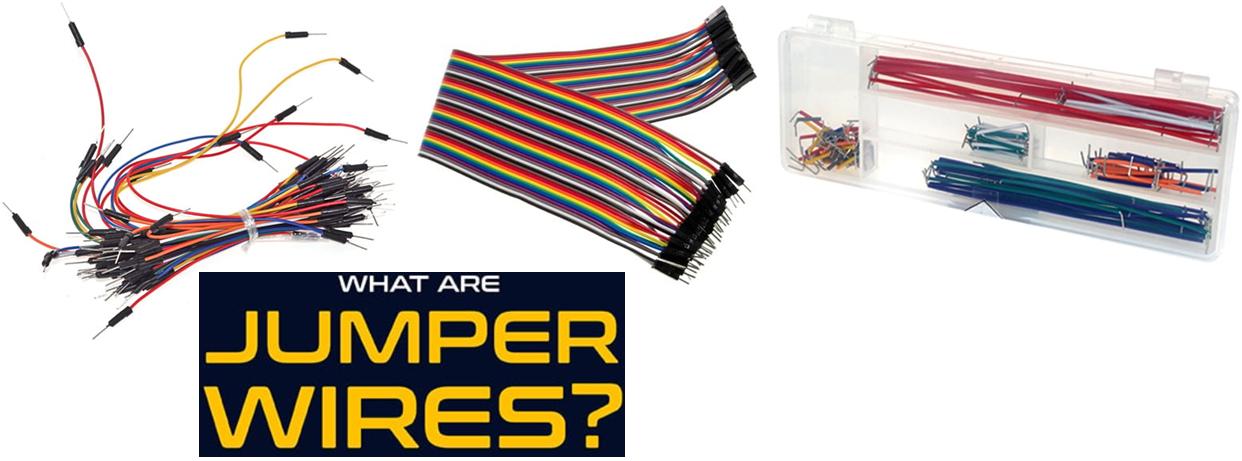
Introduction
Jumper wires are indispensable in electronics prototyping and testing. They allow engineers and hobbyists to make temporary connections on breadboards, PCBs, or between modules without soldering. Understanding their types, construction, and best practices ensures reliable, clean circuits and faster development cycles.
Construction and Materials
Jumper wires consist of a conductive core and an insulating jacket. Key aspects include:
-
Core material: Typically copper (solid or stranded) for good conductivity.
-
Insulation: PVC or silicone jackets that resist abrasion and provide flexibility.
-
Gauge: Commonly 22 AWG for breadboard use, supporting up to ~2 A at low voltages.
Electrical Characteristics
When selecting jumper wires, consider:
-
Current rating: Around 1–2 A for 22 AWG; higher gauges carry more current.
-
Voltage rating: Usually up to 250 V, though breadboard experiments are typically under 12 V.
-
Resistance: Solid-core has lower DC resistance; stranded core adds a tiny increase but remains negligible over short lengths.
Types by Connector Configuration
| Type | End A | End B | Typical Use |
|---|---|---|---|
| Male-to-Male | Pin (male) | Pin (male) | Connecting two female headers or breadboard rows |
| Male-to-Female | Pin (male) | Socket (female) | Linking modules with male pins to breadboard |
| Female-to-Female | Socket (female) | Socket (female) | Bridging two male-pin devices or headers |
Each type solves a different interfacing challenge, simplifying connections without custom cables.
Connector Head Shapes
Square Heads
Square heads have a rectangular cross-section that grips breadboard holes and PCB headers firmly. They minimize accidental disconnections in moving or vibrating setups.
Round Heads
Round heads feature a cylindrical pin or socket. They’re easier to insert in non-standard jacks or custom enclosures but may feel looser on standard breadboards.
Core Styles: Solid vs. Stranded
-
Solid-core
-
Single copper wire per jumper.
-
Excellent for rigid, neat wiring on breadboards.
-
Less fatigue resistance when bent repeatedly.
-
-
Stranded-core
-
Multiple thin copper strands twisted together.
-
Highly flexible, ideal for wires that move or flex.
-
Slightly higher resistance and marginally thicker overall diameter.
-
Color Coding
While colors carry no electrical meaning by standard, consistent schemes aid readability:
-
Red: power rails (Vcc)
-
Black: ground (GND)
-
Yellow/Green/White/Blue: signal lines, data or control buses
Adopt a personal or team convention to simplify troubleshooting and collaboration.
Special-Purpose Jumper Wires
Beyond DuPont-style pins and sockets:
-
Alligator-clip jumpers: spring-loaded clamps for temporary grip on wires or leads.
-
Banana plug jumpers: reliable connections to testers and lab power supplies.
-
RF connectors (e.g., SMA, U.FL): for radio-frequency circuits and antenna links.
-
RCA connectors: handy for composite video or audio prototyping.
Choosing the Right Jumper Wire
When selecting jumpers, evaluate:
-
Connector compatibility: match male/female ends to your headers.
-
Current and voltage needs: pick a gauge that safely carries your load.
-
Flexibility requirements: stranded cores for moving parts, solid cores for fixed layouts.
-
Length: long enough to route cleanly without excess slack.
-
Insulation durability: premium silicone jackets resist wear better than basic PVC.
Practical Applications
-
Breadboard prototyping and proof-of-concept circuits.
-
Module interfacing (e.g., Arduino, Raspberry Pi) to sensors, displays, and shields.
-
Signal injection and circuit debugging via temporary bridge connections.
-
Educational labs for hands-on learning of electronics fundamentals.
Advanced Tips
-
Pre-cut and pre-strip jumper bundles save time during repeated prototyping.
-
Use ribbon-style jumper sets to keep multi-wire buses aligned.
-
Label both ends with small heat-shrink sleeves or colored markers for complex mappings.
-
Store jumpers on pegboards or in compartmentalized boxes to avoid tangles.
Conclusion
Mastering jumper wire types and selection criteria accelerates electronics development and reduces connection headaches. By stocking male-to-male, male-to-female, and female-to-female jumpers in solid and stranded forms, along with special clips and plugs, you’ll be ready for virtually any prototyping challenge.
Now that you know all about the types of cables, buy them from QTE Technologies, the best global procurement service. QTE Technologies is an international MRO supplier proudly serving customers in over 180 countries. Established in 2010, we supply over 1 million products across all industries and engineering disciplines. Additionally, you can reach us anytime via 24×7 chat support, phone, WhatsApp or email. Discover what our valued customers have to say about our services on our dedicated review page.
Post Author By QTE Technologies Editorial Staff (with a solid background in both technical and creative writing - accumulated 15+ years of experience).




